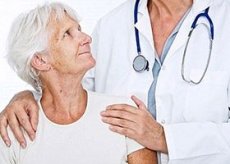Medical expert of the article
New publications
Pyelonephritis in the elderly
Last reviewed: 04.07.2025

All iLive content is medically reviewed or fact checked to ensure as much factual accuracy as possible.
We have strict sourcing guidelines and only link to reputable media sites, academic research institutions and, whenever possible, medically peer reviewed studies. Note that the numbers in parentheses ([1], [2], etc.) are clickable links to these studies.
If you feel that any of our content is inaccurate, out-of-date, or otherwise questionable, please select it and press Ctrl + Enter.

Pyelonephritis in the elderly is a non-specific infectious and inflammatory disease of the kidneys, affecting the renal parenchyma, mainly the interstitial tissue, pelvis and calyces. The disease can be unilateral and bilateral, primary and secondary, recurrent and latent.
Secondary pyelonephritis is more common in older people (against the background of diabetes mellitus, benign prostatic hyperplasia), which has a latent course.
Causes pyelonephritis in the elderly
The development of the disease is facilitated by:
Changes in organs and systems caused by aging:
- elongation and tortuosity of the ureters (often due to nephroptosis), decreased tone of smooth muscles, which slows the movement of urine through the urinary tract;
- decreased local and general immunity;
- the presence of reflux at different levels of the urinary system;
- development of sclerotic processes in the kidneys;
Circumstances that increase the risk of urinary tract infection:
- prolonged stay on bed rest (after injuries, during a severe general illness);
- fecal and urinary incontinence;
- the need for catheterization of the bladder in case of urinary retention, conducting research;
Diseases leading to urodynamic disorders: benign prostatic hyperplasia, compression of the urinary tract by fecal matter during stool retention, dehydration (with insufficient fluid intake, vomiting, diarrhea), tumors of the abdominal cavity and pelvic organs;
Diseases accompanied by changes in the composition of urine: diabetes mellitus, urolithiasis, progressive osteoporosis, gout, myeloma;
When taking medications (eg, analgesics).
Symptoms pyelonephritis in the elderly
Chronic recurrent pyelonephritis in elderly and senile people is characterized by low severity of dysuric and pain syndromes of the disease - manifestations of intoxication in the form of severe fever and homeostasis disorders with chills, impaired consciousness, shortness of breath, high risk of developing infectious toxic shock and acute renal failure come to the fore.
In the latent course of chronic pyelonephritis, the clinical picture is vague: mild pain in the lumbar region (usually in the form of a "feeling of heaviness"), an unpleasant taste in the mouth in the morning, periodic rises in temperature to subfebrile numbers, fatigue, loss of appetite, instability of stool, flatulence, the appearance of eyelid edema in the morning. Exacerbation of the disease, depending on the predominant symptoms, can have several options;
- hypertensive - increased blood pressure, relieved by anti-inflammatory therapy;
- anemic - development of normochromic anemia;
- tubular dysfunction syndrome - polyuria, isohypostenuria, thirst, dry mouth, nocturia, decreasing with antibacterial treatment;
- transient hyperazotemia - accumulation of nitrogenous waste in the body and manifestations in the form of fatigue, drowsiness, apathy, gastritis and enterocolitis.
To clarify the diagnosis, multiple urine tests are used according to Nechiporenko, bacteriological analysis, general analysis, according to the Zimnitsky method, as well as: ultrasound, excretory urography, renography, etc.
Where does it hurt?
What tests are needed?
Who to contact?
Treatment pyelonephritis in the elderly
Hospitalization and bed rest and semi-bed rest are indicated for elderly and senile patients with exacerbation of chronic pyelonephritis with severe homeostasis disorder. The choice of diet depends on the presence and severity of renal failure: in the absence of signs of renal failure, a regular geriatric diet is used with the maximum possible increase in fluid intake (about 1.5 l) and limitation of salt to 6-8 g per day (in arterial hypertension); in case of azotemia, diet No. 7 is prescribed with a significant restriction of protein.
Antibacterial therapy of the disease, if possible, should be determined by the sensitivity of the pathogen, but usually begins with the use of broad-spectrum agents: co-trimoxazole, amoxicillin, cefuroxime, fluoroquinolones (ofloxacin, ciprofloxacin), oxacillin and gentamicin (with caution). It is not recommended to use aminoglycosides, lolimixins, amphotericin B for the treatment of geriatric patients. Doses of drugs should be 30-50% lower than the average therapeutic dose.
After chronic pyelonephritis in the elderly has been stopped, long-term (6-12 months) maintenance therapy is necessary. A course of treatment with one of the antibacterial agents is carried out monthly for 10-14 days - nitrofurans (furazolidone, furadonin), nitroxalin, biseptop, urosulfan. Then phytotherapy with medicinal plants with a diuretic effect (lingonberry leaf, strawberry flowers and leaves, parsley herb and root, field horsetail, chamomile) and bactericidal action (birch leaf and buds, plantain leaf, linden flowers, calendula, eucalyptus leaves, lingonberry, cranberry berries) is used. In the presence of arterial hypertension, drugs of such drug groups as calcium antagonists, beta-blockers, ACE inhibitors, diuretics are used.
As a symptomatic therapy for anemia, iron preparations are used in combination with ascorbic acid.
To improve the reactivity of the body of an elderly person, such means as multivitamins, pentoxyl, methyluracil, etc. are used.
When caring for a geriatric patient with pyelonephritis, it is necessary to ensure adherence to the prescribed diet, periodic (at least 1-2 times a week) measurement of water balance, more frequent monitoring of the state of hemodynamic parameters and body temperature. It is important to help the patient with hygiene procedures, preparation for instrumental examinations, and urine collection. Particular attention is required for elderly and senile people on bed rest, with mental disorders, and a high risk of developing acute vascular insufficiency.


 [
[